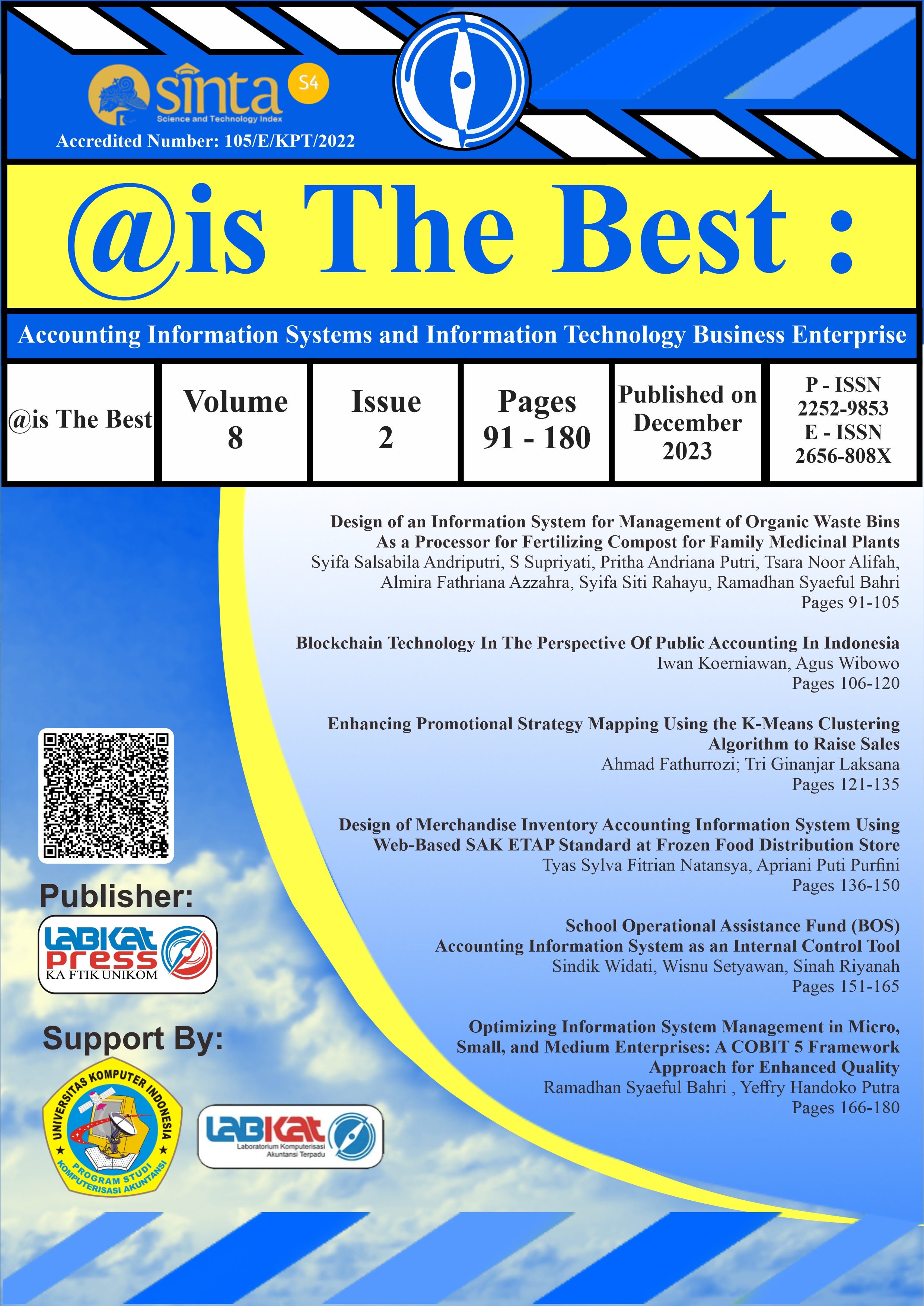Blockchain Technology In The Perspective Of Public Accounting In Indonesia
Main Article Content
Abstract
Examine the supporting and inhibiting factors for the readiness to adopt blockchain technology and their implications for the sustainability of the public accounting profession. This research design is quantitative, by determining the population of all public accountants in KAPs throughout Indonesia, as many as 6,034 people. Probability sampling design, with reference to the sample size if the population is > 4,000 then between 5-10% can be considered representative. Based on this, the sample in this study was set at 7.2% (433 respondents). The main data source is primary data, through a questionnaire instrument with a Likert scale that strongly disagrees to strongly agrees. The independent variables consist of supporting and inhibiting factors, mediating variables on the readiness to adopt blockchain technology, and the dependent variable on the sustainability of the public accounting profession. Testing was carried out using path analysis, which was first tested for the validity of Kaiser Meyer Olkin (KMO), and the reliability of Alpha Cronbach. Conclusion: Supporting and inhibiting factors partially have a positive and significant effect on the readiness to adopt blockchain technology as well as on the sustainability of the public accounting profession. The readiness for blockchain adoption has no effect on the sustainability of the public accounting profession, so it is not a reinforcing variable.
Downloads
Article Details
Section

This Journal is licensed under a Creative Commons Attribution-ShareAlike 4.0 International License
How to Cite
References
Mantelaers, EJHJ. “An Evaluation of Technologies to Improve Auditing,” Dissertations, Open University, ISBN : 978-94-6416-637-8. 2021.
B. Ozkeser, “Lean Innovation Approach in Industry 5.0.,” The Eurasia Proceedings of Science Technology Engineering and Mathematics (2), 422-428, 2018.
T.M. Patterson, “The Effects Of Big Data And Blockchain On The Audit Profession,” Dissertations, Liberty University, 2022.
Z.H. ALSaqa, A.I. Hussein, and S.M. Mahmood, “The Impact of Blockchain on Accounting Information Systems,” Journal of Information Technology Management, Vol. 11. No. 3. Pp. 62-80, 2019, Doi : 10.22059/jitm.2019.74301.
F. Bruckner, “From Auditing To Auditing 4.0: The Impact Of Artificial Intelligence And Blockchain Technology On The Business Model Of The Big Four Auditing Companies,” Master Thesis, Austria, Johannes Kepler University Linz, 2022.
Y. Wang and A. Kogan, “Designing Confidentiality-Preserving Blockchain-Based Transaction Processing Systems,” International Journal of Accounting Information Systems, Vol. 30. Pp. 1-18, 2018.
N. Brender and M. Gauthier, “Impacts of Blockchain on The Auditing Profession,” Information Systems Audit and Control Association Journal , Vol 5. No 12. Pp. 27-32, 2018.
Bible, W., Raphael, J. & Taylor, P.. “Blockchain Technology and Its Potential Impact on the Audit and Assurance Profession,” Deloitte Development LLC. 277 Wellington Street West Toronto, in Canada, 2017.
V.M.S. Gero and I.M.S. Suardikha, “Factors Supporting and Inhibiting Intention to Use Blockchain by Auditors in Public Accounting Firms,” E-Journal of Accounting . Vol. 30 No. 10. 30(10). e-ISSN : 2302-8556. Pp.: 2604-2618, 2020, Doi : 10.24843/EJA.2020.v30.i10.p13.
Noteisen, B. & Weinhardt, C., “The Blockchain, Plums, And Lemons: Information Asymmetries & Transparency In Decentralized Markets, “ Working Paper Series In Economics. No. 130, February, 2019.
Shaffer, KJ, Gaumer, CJ, & Bradley, KP, “Artificial Intelligence Products Reshape Accounting: Time To Re-Train.” Development and Learning in Organizations: An International Journal, 2020.
Dai, J., Three Essays On Audit Technology: Audit 4.0, Blockchain, And APP Audit. Dissertations. University of New Jersey, 2017.
Arnab, R., “Survey Sampling Theory and Applications,“ Elsevier Ltd. ISBN 978-0-12-811848-1, 2017
Ghozali, I. “Multivariate Analysis Application With IBM SPSS 23 Program. Print VIII”. Diponegoro University, Semarang 2018)
Lescevica, M., Ginters, E. & Mazza, R., “Unified Theory ff Acceptance and Use of Technology (UTAUT) for Market Analysis of FP7 CHOReOS Products,” Procedia Computer Science 26. Pp. 51–68, 2013.
Kim, HW & Kankanhalli, “A. Investigating User Resistance to Information Systems Implementation: A Status Quo Bias Perspective,” MIS Quarterly. Vol 33. No. 3. Pp. 567-582, 2009.
Venkatesh, V., & Zhang, X. “Unified Theory of Acceptance And Use of Technology : US Vs China,” Journal of Global Information Technology Management, Vol 13. No 1. Pp. 5-27, 2010.
Faccia, A., Naqbi, MYKA & Lootah, SA., “Integrated Cloud Financial Accounting Cycle. How Artificial Intelligence, Blockchain, and XBRL will Change the Accounting, Fiscal and Auditing Practices,” ICCBDC 2019: Proceedings of the 2019 3rd International Conference on Cloud and Big Data Computing . August 2019. Pp. 31–37, 2019.

